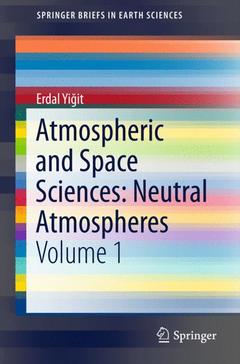Atmospheric and Space Sciences: Neutral Atmospheres, 1st ed. 2015 Volume 1 SpringerBriefs in Earth Sciences Series
Auteur : Yiğit Erdal

The SpringerBriefs on Atmospheric and Space Sciences in two volumes presents a concise and interdisciplinary introduction to the basic theory, observation & modeling of atmospheric and ionospheric coupling processes on Earth. The goal is to contribute toward bridging the gap between meteorology, aeronomy, and planetary science. In addition recent progress in several related research topics, such atmospheric wave coupling and variability, is discussed. Volume 1 will focus on the atmosphere, while Volume 2 will present the ionosphere? the plasma environment. Volume 1 is aimed primarily at (research) students and researchers that would like to gain quick insight in atmospheric sciences and current research. It also is a useful tool for professors who would like to develop a course in atmospheric physics.
1 A Brief Overview of Atmospheric and Space Sciences
1.1 Earth as a Special Habitat
1.2 Atmospheric and Space Sciences: Toward Unification
1.3 International Activity in Atmosphere-Ionosphere Science
1.4 Planetary Science Context
2 Introduction to Atmospheric Physics
2.1 Introduction to Earth’s Atmosphere
2.2 Basic Atmospheric Parameters and Coordinate System
2.3 Continuum Hypothesis
2.4 Atmospheric Composition
2.5 Universal Gravity
2.6 Equation of State: Ideal Gas Law
2.7 Thermodynamic Laws
2.8 Heat Capacity
2.9 Geopotential
2.10 Hydrostatic Equilibrium
2.11 Potential Temperature
2.12 Atmospheric Stability
2.13 Transport Phenomena
2.14 Richardson Number
2.15 Reynolds
Number
3 Some Mathematical Basics: Conservation Laws
3.1 Introduction
3.2 Reference Frames in Fluid Dynamics
3.3 Material Derivative
3.4 Rotational Effects
3.5 Conservation of Momentum
3.6 Conservation of Energy
3.7 Conservation of Mass
3.8 Incompressible Flow
3.9 Governing Equations of Atmospheric Dynamics
3.10 Vertical Coordinate System
4 Earth’s Atmosphere and Geospace Environment
4.1 Sun-Earth Connection
4.2 Sun
4.3 Heliosphere
4.4 Magnetosphere
4.5 Plasmasphere
4.6 The Atmosphere-Ionosphere System
4.7 Neutral Atmosphere
4.8 Ionosphere
5 Waves in Terrestrial and Planetary
Atmospheres5.1 Notion of Waves
5.2 Introduction to Basic Wave Parameters
5.3 Wave Equation
5.4 Internal Waves
5.5 Wave Generation
5.6 Gravity Waves
5.7 Large-Scale Waves
5.8 Wave Decay
5.9 Observation of Waves in the Atmosphere
5.10 Effects of Waves in Terrestrial and Planetary Atmospheres
6 Atmospheric Circulation and Dynamical Processes
6.1 Eddy and Vortex
6.2 Radiative Equilibrium
6.3 Concept of Circulation
6.4 General Circulation
6.5 General Circulation Modeling
6.6 Circulation Patterns in the Atmosphere
6.7 Eulerian Mean
6.8 Transformed Eulerian Mean (TEM)
6.9 Sudden Stratospheric Warming
6.10 Atmospheric Vertical Coupling and Gravity Waves during Sudden
Warmings
Physical Constants and Parameters
Useful Mathematical Tools
Glossary
Index
Includes supplementary material: sn.pub/extras
Date de parution : 08-2015
Ouvrage de 110 p.
15.5x23.5 cm



